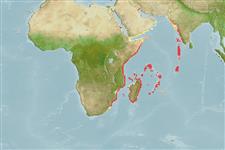Environment: milieu / climate zone / depth range / distribution range
Ökologie
seewasser riff-verbunden. Tropical
Western Indian Ocean: Kenya and Mozambique to islands in the western Indian Ocean.
Size / Gewicht / Alter
Maturity: Lm ? range ? - ? cm
Max length : 21.0 cm SL Männchen/unbestimmt; (Ref. 3503); common length : 20.0 cm TL Männchen/unbestimmt; (Ref. 5450)
Rückenflossenstacheln (insgesamt): 12; Rückenflossenweichstrahlen (insgesamt): 9; Afterflossenstacheln 3; Afterflossenweichstrahlen: 5. A black spot nearly as large as eye on inner surface of pectoral fins near base of first 5 rays; no black mark inside mouth at front of upper jaw. Ascending process of premaxilla narrow, its maximum width 1.8-2.2 in orbit diameter; a series of papillae or nodules (sometimes on a low ridge) across interorbital space between supraocular spines; nasal spine single (Ref 42181).
Usually found immobile at the bottom camouflaged among rocks and coral. Hunts by ambushing prey (Ref. 5503). Unlike most scorpaenids, the sting from the dorsal spines of this species can be painful but does not pose any real danger to the victim (Ref. 5503). Sold fresh in small quantities in markets.
Life cycle and mating behavior
Geschlechtsreife | Fortpflanzung | Ablaichen | Eier | Fecundity | Larven
Randall, J.E and W.N. Eschmeyer, 2001. Revision of the Indo-Pacific scorpionfish genus Scopaenopsis, with descriptions of eight new species. Indo-Pac. Fish. (34):79 p. (Ref. 42181)
IUCN Rote Liste Status (Ref. 130435)
Bedrohung für Menschen
Traumatogenic (Ref. 5503)
Nutzung durch Menschen
Fischereien: weniger kommerziell
Mehr Information
NamenSynonymeMetabolismusRäuberÖkotoxikologieFortpflanzungGeschlechtsreifeAblaichenSpawning aggregationFecundityEierEientwicklung
ReferenzenAquakulturAquakultur ProfilZuchtlinienGenetikElectrophoresesVererbbarkeitKrankheitenVerarbeitungNutrientsMass conversion
PartnerBilderStamps, Coins Misc.LauteCiguateraGeschwindigkeitSchwimmstilKiemenoberflächeOtolithsGehirngrößeSehfähigkeit
Tools
Zusatzinformationen
Download XML
Internet Quellen
Estimates based on models
Preferred temperature (Ref.
123201): 25 - 28.9, mean 27.2 °C (based on 444 cells).
Phylogenetic diversity index (Ref.
82804): PD
50 = 0.5000 [Uniqueness, from 0.5 = low to 2.0 = high].
Bayesian length-weight: a=0.01259 (0.00606 - 0.02615), b=3.03 (2.86 - 3.20), in cm total length, based on LWR estimates for this (Sub)family-body shape (Ref.
93245).
Trophic level (Ref.
69278): 4.2 ±0.73 se; based on food items.
Widerstandsfähigkeit (Ref.
120179): mittel, Verdopplung der Population dauert 1,4 - 4,4 Jahre. (Preliminary K or Fecundity.).
Fishing Vulnerability (Ref.
59153): Low vulnerability (16 of 100).
Nutrients (Ref.
124155): Calcium = 61.9 [32.2, 128.5] mg/100g; Iron = 0.667 [0.347, 1.661] mg/100g; Protein = 18.1 [16.1, 20.1] %; Omega3 = 0.232 [0.101, 0.641] g/100g; Selenium = 27 [14, 69] μg/100g; VitaminA = 256 [83, 745] μg/100g; Zinc = 1.19 [0.80, 1.75] mg/100g (wet weight);
